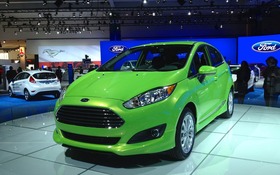Ford at the L.A. Auto Show: New Fiesta and Transit Connect
Ford chose the Los Angeles Auto Show to launch new versions of the restyled Fiesta featuring new drivetrains for 2013. At the same time, the American automaker unveiled new wagon variations of its Transit Connect van. The prices of all these new versions have not yet been determined and will be announced at a later date.
The different Fiesta trims that will debut in the spring of 2013 feature a new bumper and hood in front, but the most obvious changes are mechanical. There’s a new 1.0-litre three-cylinder turbocharged engine that develops 123 horsepower and 148 lbs.-ft. of torque, as well as a 1.6-litre EcoBoost engine for the Fiesta ST that produces 197 horses and 214 lbs.-ft. of torque.
As a result, the Fiesta ST now pumps more power than the Mini Cooper S, and its size and weight also give it a weight-to-power ratio advantage over the Volkswagen GTI. Available only in a five-door configuration, the Fiesta ST will deliver its power and torque exclusively to the front wheels by way of a six-speed manual gearbox. Its suspension is more firmly calibrated in addition to being 15 millimetres lower than the other trims in the line-up. Moreover, the steering is faster with a ratio of 13.6:1 and the electronic Torque Vectoring Control should help keep understeer in check by delivering more power to the outside wheel on corners. The Fiesta ST is also equipped with an electronic stability control system that can be calibrated in three modes: standard, sport and – for all you Ken Block imitators out there – completely deactivated to take full advantage of the engine sound by way of a sound symposer that allows sound to pass into the cockpit.
In the last quarter of 2013, the Fiesta with the 1.0-litre three-cylinder Ecoboost engine will enter the Canadian market as a 2014 model offered only in a five-door configuration and exclusively with a five-speed manual transmission. The engineers had a major technical challenge to reduce the vibrations that are inherent to engines with an odd number of cylinders. The traditional approach has been to equip these engines with a crankshaft balancer, but the design team chose against this option so as not to add to the car’s weight and fuel consumption. Instead, they applied external balancing using the crankshaft pulley and the flywheel while sending the engine mounts into the car’s chassis. Unfortunately, the Start-Stop system that will be offered on this model in Europe will not be available in North America – at least not for now.
Transit Connect: A growing family
Launched on the North American market in 2009, the Transit Connect van helped Ford successfully attack the commercial vehicle market. With the arrival of the second generation developed on the C1 platform that supports the Focus, Escape, C-Max and the European Kuga, the American manufacturer wants to broaden the market by proposing a new extended version called Transit Connect Wagon, designed for the average person. This new vehicle, which will be available in Canada in the fourth quarter of 2013, is a van with three rows of seats. It can accommodate seven passengers and will be offered in XL, XLT and Titanium versions. Redesigned by the Ford England-based design team, the Transit Connect Wagon retains certain commercial vehicle traits, such as elevated taillights, thus saving them from mishaps when the driver parks “by ear” or “by touch”. It also adopts a new dashboard borrowed from the Focus that makes it look a bit more “high end.” Also note that the Titanium trim will be available with leather seats, a panoramic sunroof and navigation system, marking an obvious break with this cargo van’s more humble beginnings.
The North American market will have only two gasoline engines, namely a 2.5-litre four-cylinder or 1.6-litre four-cylinder EcoBoost. The sole transmission is a six-speed automatic. In Europe, 100% of Transit Connect vans are equipped with a diesel engine and a manual transmission.












